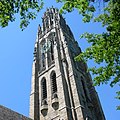| Name | Class Year | Profile |
|---|
| Timothy Dwight IV | 1767 | American academic and educator, Congregationalist minister, theologian, and author. He was the eighth president of Yale College (1795–1817). |
| Abraham Baldwin | 1772 | American politician, Patriot, and Founding Father from the U.S. state of Georgia. Baldwin was a Georgia representative in the Continental Congress and served in the United States House of Representatives and Senate after the adoption of the Constitution. Baldwin was the founding father of the University of Georgia, the first state-chartered public institution of higher education in the United States, and served as its first president. |
| Nathan Hale | 1773 | American patriot, spy for General George Washington, and the state hero of Connecticut. |
| James Hillhouse | 1773 | American lawyer, real estate developer, and politician from New Haven, Connecticut. He represented Connecticut in both the U.S. House and Senate. |
| Eli Whitney | 1789 | American inventor best known for inventing the cotton gin. |
| Jeremiah Day | 1789 | American academic, Congregational minister, and President of Yale College (1817–1846). |
| James Fenimore Cooper | 1806 | Prolific and popular American writer of the early 19th century, author of Last of the Mohicans . |
| Henry Leavitt Ellsworth | 1810 | Yale-educated attorney who became the first Commissioner of the U.S. Patent Office, where he encouraged innovation by inventors Samuel F.B. Morse and Samuel Colt. Ellsworth also served as the second president of the Aetna Insurance Company. He was also a major donor to Yale College, a commissioner to Indian tribes on the western frontier, and the founder of what became the United States Department of Agriculture. |
| Roger Sherman Baldwin | 1811 | American lawyer involved in the Amistad case, who later became the 32nd Governor of Connecticut and a United States Senator. |
| Asa Thurston | 1818 | First American Christian missionary to the Hawaiian Islands. |
| Nathaniel Parker Willis | 1827 | American author, poet, and editor who worked with several notable American writers including Edgar Allan Poe and Henry Wadsworth Longfellow. He became the highest-paid magazine writer of his day. |
| Frederick Augustus Porter Barnard | 1828 | Classical and English scholar, mathematician, physicist, chemist, and advocate for women's higher education. He was the tenth president of Columbia University. |
| Noah Porter | 1831 | American academic, philosopher, author, lexicographer, and President of Yale College (1871–1886). |
| Ebenezer Kingsbury Hunt | 1833 | Prominent physician in Hartford, Connecticut. The E.K. Hunt Chair of Anatomy at Yale University is named after him. |
| William M. Evarts | 1837 | American lawyer and statesman who served as U.S. Secretary of State, U.S. Attorney General, and U.S. Senator from New York. |
| Josiah Whitney | 1839 | American geologist, professor of geology at Harvard University, and chief of the California Geological Survey. Mount Whitney and Whitney Glacier were named in his honor. |
| Joseph Gibson Hoyt | 1840 | First chancellor and professor of Greek at Washington University in St. Louis (then named Washington Institute in St. Louis) from 1858 to 1862. |
| Timothy Dwight V | 1849 | American academic, educator, Congregational minister, and President of Yale College (1886–1898). Under his leadership, Yale developed into a university. |
| Daniel Coit Gilman | 1852 | Founder of the Sheffield Scientific School at Yale College, early president of the University of California, first president of Johns Hopkins University, and founding president of the Carnegie Institution. He was also a co-founder of the Russell Trust Association, which administers the business affairs of Yale's Skull and Bones society. |
| Andrew Dickson White | 1853 | U.S. diplomat, historian, and educator, co-founder of Cornell University. |
| Chauncey Mitchell Depew | 1856 | Attorney for Cornelius Vanderbilt's railroad empire, president of the New York Central Railroad System, and U.S. Senator from New York (1899-1911). |
| Brinley D. Sleight | 1858 | Newspaper editor, member of the New York State Assembly |
| Francis Miles Finch | 1859 | American judge, poet, and academic associated with the early years of Cornell University. Author of the famous poem "The Blue and the Gray". |
| Elisha Jay Edwards | 1870 | Investigative journalist and financial reporter known for exposing President Grover Cleveland's secret cancer surgery. |
| Walter Camp | 1875 | American football player, coach, and sports writer, known as the "Father of American Football". |
| William Howard Taft | 1878 | President of the United States (1909-1913), Chief Justice of the United States (1921-1930), Judge on the Cincinnati Superior Court, Solicitor General of the United States, Judge on the United States Court of Appeals for the Sixth Circuit, Governor-General of the Philippines, and Secretary of War under President Theodore Roosevelt. In the late 19th century, Taft advocated for and attempted a revival of Linonia. He is also a member of Skull and Bones. |
| Dick Celeste | 1959 | 64th Governor of Ohio, U.S. Ambassador to India, and 12th President of Colorado College. |
| Les Aspin | 1960 | 18th U.S. Secretary of Defense and representative for Wisconsin's 1st Congressional District. [14] |





